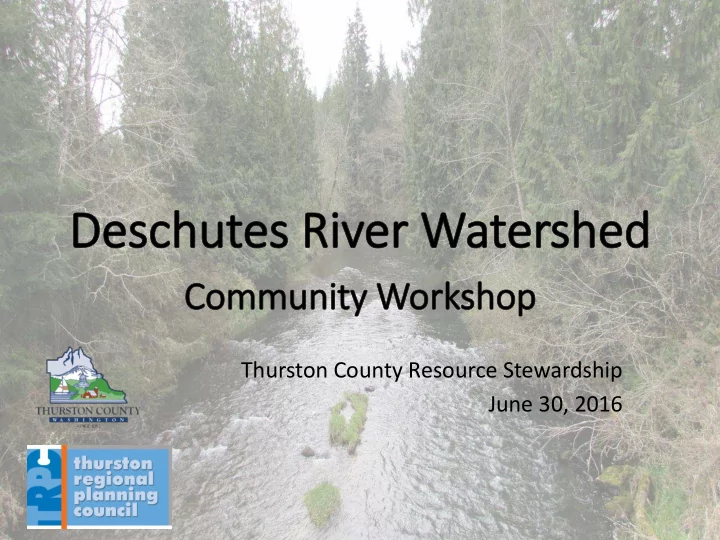

Thurston County Resource Stewardship June 30, 2016
Tonight’s Agenda • Background • Project • Watershed Issues • Management Options & Recommendations • Q & A • Table Stations
Guiding Growth – Healthy Watersheds Project Background • Thurston County is one of the fastest growing in Western Washington – How to best protect and improve water resources as our region grows? • 2014: Thurston County and TRPC received a grant to conduct watershed-based planning in the Deschutes
Where is the Deschutes Watershed?
Water Resource Concerns • Deschutes River and tributaries are listed as impaired under the Clean Water Act • State clean-up plan released in 2015
Impervious Surface and Forest Cover
Bacteria and Pathogens in Surface Water Potential sources of fecal coliform include: • Farm animal wastes • Stormwater runoff • Improperly connected sewers • Failing septic systems • Pet wastes
Bacteria and Pathogens in Surface Water Current Concerns • Spurgeon Creek • Reichel Creek Future Concerns • 171% increase in septic systems on non-porous soils near waterbodies
Increased Nutrients and Algae Blooms Primary cause of algae blooms: • Phosphorous from septic systems • Stormwater runoff and fertilizers • Erosion
Increased Nutrients and Algae Blooms Current Concerns • Lake Lawrence • Reichel Creek, Lake Lawrence Creek, and an unnamed tributary
Increased Nutrients and Algae Blooms Future Concerns • 171% increase in septic systems on non-porous soils near water bodies • Impervious area in Offutt Lake basin: 3.4% to 6.8% at buildout • Loss of forest cover in Offutt Lake basin – 55% today to 47% - similar to Lake Lawrence today
Sediment and Erosion Risk of landslides increases with removal of vegetation and road building Erosion adds fine sediments to stream, degrading salmon spawning habitat
Sediment and Erosion Current Concerns Deschutes River Coho Salmon Smolts - Cohort B • Erosion along stream 80,000 banks 70,000 • Risk of landslides Landslides during the Smolts (brood year) 60,000 winter storms in 1990 and 1996 destroyed the Future Concerns 50,000 Coho Salmon run (eggs laid in 1989 and 1992). 40,000 The run has not • Need for stream bank recovered. 30,000 restoration 20,000 • Up to 6% loss of forest 10,000 lands on steep slopes - 1980 1983 1986 1989 1992 1995 1998 2001 2004 2007 2010 2013
Indicators
Stream Temperature
Indicators
Water Levels During Drought Periods Current Concerns Rainier Gage Summer Low Flow • Low summer stream (lowest 7 day average) flows in Deschutes 50 River and effect on Summer Low Streamflow (cubic feet per second) 40 Coho salmon 30 Futures Concerns • Potential for over 20 3,000 new homes in 10 study area - • Up to a 96% 1950 1960 1970 1980 1990 2000 2010 2020 Summer low flow (lowest 7 day average) increase in water Lowest Flow of Decade consumption
Water Levels During Drought Periods Normalized Summer Streamflow Summer streamflow (July to September) divided by Summer Precipitation (May to September) Deschutes River – Rainier Gage 14 Normalized streamflow 12 10 8 6 4 2 - 1950 1960 1970 1980 1990 2000 2010
Water Levels During Drought Periods
Indicators
Loss of Farmland Futures Concerns Current Concerns • Over 3,000 acres • Over 700 acres lost vulnerable to between 2000 and urbanization 2011
Loss of Farmland – 2000 & 2015
Groundwater Quality Current Concerns • Failing septic systems contribute nitrates to ground water Future Concerns • Up to 59% increase in homes on septic systems on porous soils; 20% increase if Rainier is converted to sewer.
Community Workgroup • Diverse members • Considered and evaluated different land use management options • Direction on future scenarios • Provided a suite of recommended land use policies
Solutions • Baseline • Zoning Downzone parcels Current Regulations Buildout Nonporous soils near waterbodies Steep slopes Lake basins • Education & Outreach Voluntary restoration program • Regulations & Monitoring More farm plans Voluntary septic O&M program Impervious surface limits, lake basins Water conservation outreach Mandatory septic O&M program Required water metering • Restoration & Conservation Funded conservation/restoration programs Stormwater retrofits
Solutions • Education & Outreach • Zoning Downzone parcels Low to Moderate effectiveness for most water Low to moderate quality concerns effectiveness at reducing sources of nutrients, bacteria, sediment, impacts • Restoration & to groundwater Conservation • Regulations & Monitoring Most effective for reducing stream temperatures, Most effective for reducing nutrients, and sediment impacts to groundwater quality and bacteria sources
Next Steps • Public feedback on management options • Final results shared with Board of County Commissioners and used in future planning projects
Questions? Staff Contacts Charissa Waters Allison Osterberg Associate Planner Senior Planner (360) 786-5541 (360) 754-3355 x7011 watersc@co.thurston.wa.us osterba@co.thurston.wa.us
Recommend
More recommend